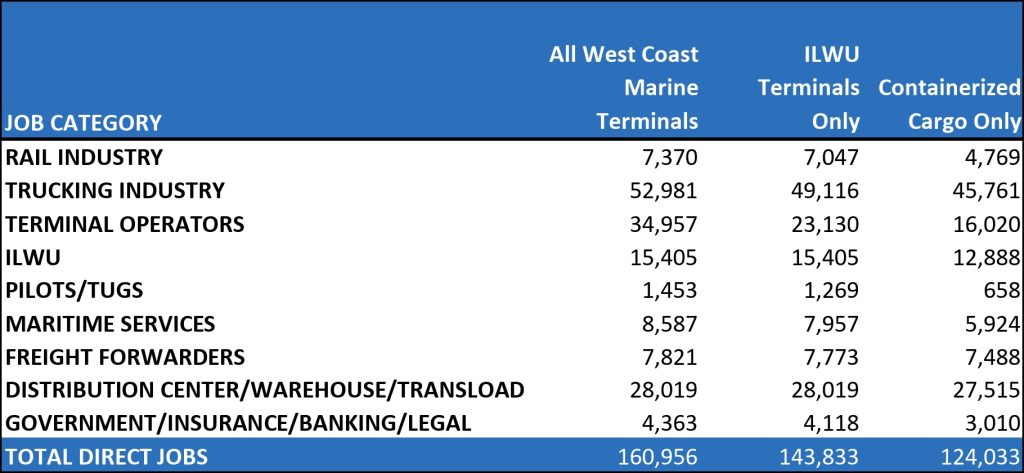This new research by noted maritime economist John Martin, PhD., and Martin Associates, commissioned by the Pacific Maritime Association, highlights the enormous economic impact of West Coast ports at the regional and national levels. Developed using a detailed methodology, the research demonstrates how port activity touches nearly every aspect of the U.S. economy and communities nationwide.
Trans-Pacific trade passing through West Coast ports provides jobs and economic stimulus in the West Coast region and supports vital sectors of the economy nationwide – comprising small and large businesses in agriculture, food, retail, manufacturing, and other sectors.
In fiscal year 2021, cargo and vessel activity at West Coast ports supported more than 12 million jobs and nearly $2 trillion of total economic value throughout the U.S. That figure represents approximately 8.7 percent of the nation’s GDP. In total, ports in California, Washington and Oregon are collectively the largest gateway for waterborne cargo entering North America, accounting for 37% of all imports to the United States in 2021.
A Powerful Economic Engine: In fiscal year 2021, the cargo and vessel activity at all marine terminals located within the 27 West Coast deep-water port districts supported 12.5 million jobs in the U.S. economy. Cargo activity at West Coast marine terminals generated some 161,000 direct jobs; 291,000 induced jobs connected to the re-spending of $50.3 billion in local purchases; and more than 84,000 indirect jobs supported by the $6.5 billion of goods and services purchased by the firms employing the direct jobholders. Nearly 12 million jobs generated by West Coast port activities were with shippers and recipients of cargo, including containerized cargo, autos, break bulk, agricultural products and more.
Total Jobs Supported in the U.S. by West Coast Port Activities in FY 2021

Creating Jobs Far Beyond Port Terminals: The impact of jobs supported by West Coast ports extends far beyond the marine terminals and into all parts of the supply chain. Martin Associates found that the more than 15,500 registered ILWU members account for just 10% of the direct jobs supported by West Coast ports, with the remaining 90% of jobs spread throughout the supply chain.
The leading direct jobs at West Coast port facilities included nearly 53,000 jobs in the trucking industry; nearly 35,000 jobs for terminal operators; and just over 28,000 jobs in distribution centers, warehouses and transload facilities. Marine cargo and vessel activity at West Coast ports supported 15,405 ILWU members in fiscal year 2021.
Direct Jobs Generated by Cargo and Vessel Activity at the West Coast Ports in FY 2021

In fiscal year 2021, direct, indirect, and induced jobs generated by West Coast port activity supported $501.5 billion in personal wage and salary income and personal consumption throughout the U.S. The approximately 161,000 workers directly employed earned an average salary of $78,900. Marine cargo and vessel activity at West Coast ports supported $113.5 billion in federal tax revenue, in addition to $43.1 billion of state and local tax revenues throughout the U.S. These tax dollars were paid by both corporations and individuals with jobs supported by West Coast ports.
Navigating Current and Future Challenges: The enormous economic reach of the West Coast ports has coincided with supply chain disruptions that have occurred over the last two years. Previous research by Martin Associates detailed the nature and extent of these disruptions at the San Pedro Bay ports, as shortages of truckers, warehouse space, and chassis contributed to delays, shortages, and increased prices nationwide. Developing long-term solutions to address supply chain challenges, including solutions at West Coast maritime terminals, will be vital to supporting the ports’ powerful impact on American jobs and businesses.
Terminals at the San Pedro Bay Port Complex are on pace to reach capacity as early as 2028. Because the physical footprints of West Coast marine terminals are often constrained in landlocked urban settings, terminals must find ways to densify their operations to continue to meet current and future cargo volumes. The nation’s economy, and millions of jobs, depend on it.
